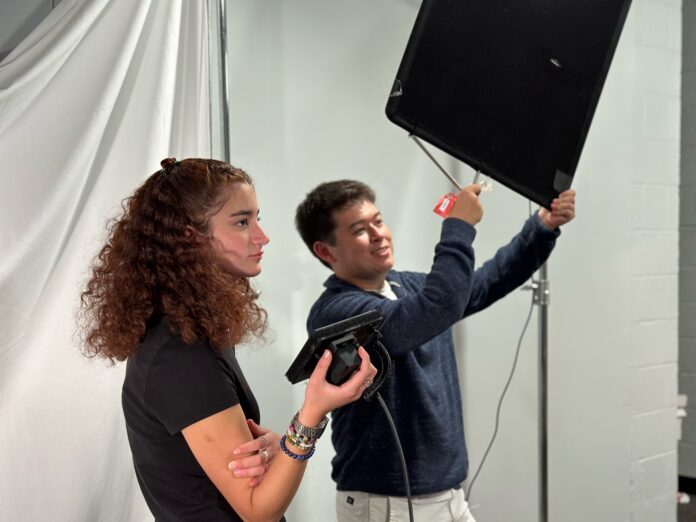
“Right Behind You” is an independent film written and directed by Sophie Stein ‘25 and co-produced with Raymond Ceres ‘25, director of photography. Set in a small town in the ‘80s, “Right Behind You” follows the story of Eli, a Jewish high school senior on the track team, and Tom, a fellow track athlete whose competitiveness is heavily intertwined with his antisemitic beliefs. The film follows their two stories as the tension between them peaks.
The script originated from Visiting Assistant Professor of Theatre & English Gabriel Dean’s Intro to Screenwriting class, a course Stein took in her first year at Muhlenberg. “The inspiration for this film was a bit of a mix between stories my dad would tell me about growing up in the ‘80s as the Rabbi’s son, and my own experiences and emotions as a Jewish teenager… resulting in a script about a teenager’s struggle with antisemitism, and the helplessness of not knowing how to handle it,” said Stein.
This past summer, Stein and Ceres were writing a short comedy when the script for “Right Behind You” came up. Stein explained, “[Ceres] asked me if I would ever consider shooting it, and from there we began playing with the idea of this project, leaving the comedy for another time. ‘Right Behind You’ just seemed like a more promising script as it was.”
“I was attracted to this project because of all the challenges it would entail, on both a producing and cinematography level. To make a project at this scale, there were huge obstacles for us to tackle, as we started from a place of no actors, no funding and no location permissions,” said Ceres. “There was so much uncertainty hanging over us as we prepared to post our casting calls and launch our GoFundMe campaign.”
A notable aspect of the student film is that aside from Dan Harel ‘26, who plays Eli, the majority of the actors in the film are not affiliated with Muhlenberg College. In early August, Ceres and Stein began posting casting calls on websites such as Backstage and Actors Access. This was due to a majority of the cast consisting of adult male actors.
“Personally, I wasn’t anticipating much success, but we ended up getting over 300 submissions. From there, we asked actors for self-tapes and then moved to callbacks on Zoom. We spent multiple days on Zoom with different actors, reading sides with them and talking in-depth about the characters. It meant a lot to me that people believed in the project and wanted to be a part of it. After callbacks, it was clear almost immediately who was right for the roles, and we met with all of our actors again before officially casting them. It was then that the project actually started feeling real,” said Stein.
Anthony Mark Mancini, who plays Coach said, “I responded to a casting notice on Backstage.com followed by a self-tape audition. I was an actor in the ‘80s and ‘90s [and] then I took a lifetime hiatus to do other things. I have recently returned to the acting world and [working with Ceres and Stein] was wonderful. Recently I have been working with a lot of young filmmakers and it’s been a joy to be around their youthful energy.”
Siddy Greenstein, who plays Tom, is a sophomore from New York University who commuted to Allentown on the weekends that were scheduled for filming. “It was a very fun experience working with fellow students Raymond and Sophie. Even though this was a student film, leading up to filming, the preparation period felt very professional.”
Greenstein reflected, “One favorite moment during filming was when we were filming the Tom bedroom scenes. You get to see a small section of Tom’s home life and the set was just amazing. It seemed like everything you could find from the ‘80s had been plastered all over the wall.”
As this was a period piece, everything from the costumes to the set design had to be reminiscent of the 80s. “Since this is a period piece, set in a small rural town, we had to account for a lot. We couldn’t use any modern-looking outfits, so virtually every single article of clothing in the film was purchased by us. There were many trips made to the thrift store and huge purchases from Amazon and other random websites. I also borrowed quite a few items from my dad’s old wardrobe, which proved extremely helpful because we got to incorporate a bunch of authentic ‘80s pieces,” said Stein.
Ceres added, “Once we committed to not compromising on accuracy, we have been paying attention to the smallest details– from the Coach’s stopwatch to one of the characters’ alarm clocks.”
Through a GoFundMe page created to help with production costs, Stein and Ceres raised about $3,500 only after about a month of fundraising.
When they arrived on campus, they began working on the project immediately. Since the majority of the film takes place outside and is focused on track athletes, Ceres explained that “As soon as we got back to campus we immediately underwent test shoots, mainly to determine the best methods for camera stabilization. The trial and error of these test shoots allowed us to decide on a visual look for the film and establish rules for movements and compositions that would violate or accomplish our vision.”
As for filming outside, Stein added, “Turns out shooting a primarily exterior film is quite the feat. Working around the weather is incredibly unpredictable, especially when it decided to rain nearly every weekend for the past two months.”
“When shooting exteriors, you have far less visual control so it is important to plan shoots based on weather, cloud coverage and time of day, especially since some scenes demand certain conditions to achieve a desired mood or demand conditions that will be consistent with footage shot on a different day,” said Ceres. “Scheduling is always difficult, but it is even more difficult with how unpredictable these factors are, and even more complicated since we have had to coordinate shoots based on the availability of locations as well as the availability of actors coming in.”
In addition to filming in Muhlenberg’s facilities, the women’s locker room and Everson House, the majority of filming took place on Lafayette’s track and field. They rented an Airbnb for filming as well.
This is Stein’s first time directing a film of this scale, and she reflected that “Directing is rather bizarre at times because it is unlike any other dynamic I have experienced in real life. You suddenly have all of the authority over a project that everyone has their own thoughts and opinions on.”
To help navigate the role of director, Stein dove into research. “There was a lot to learn–from respectfully talking to actors, to giving strong notes, to leading productive rehearsals. I reached out to a handful of actors at Muhlenberg and listened to the way they spoke about their own acting process and what they found most meaningful in their experience with directors.”
Thomas Wechsler, who plays Iz, shared that “I love working with student filmmakers [because] they are passionate about the work [they do]. Raymond and Sophie are great to work with, professional and extremely dedicated to the project and the craft. They work hard to make sure every scene is exactly right, and that makes the actors comfortable with their performance. I have the utmost respect for them and the rest of the actors and crew.”
As for balancing the film and being full-time students, Stein explained, “It’s a lot of go, go, go and getting school work done during any spare time you have. We quickly became accustomed to getting very little sleep and not thinking about much else besides the project. At times it felt like we were just going to our classes and grabbing dinner in between working on the film. It consumes you in a way that probably appears concerning to the onlookers of your life.”
“It [was] overwhelming at times, especially without the support of a class or professor dedicated to the creation of the film,” added Stein. “No one was there to tell us the challenges of shooting exterior, or of stabilizing a camera while tracking two actors running and talking at the same time, or of coordinating a shoot with 15-plus people. Everyone I reached out to at Muhlenberg was a huge help and I am immensely grateful for all of the knowledge they gave me, but in the end, this project was created independently and we had to figure out a lot by ourselves.”
Lindsey Biggs ’25, 1st assistant director, shared, “There were countless late nights and early mornings, and we all poured such a massive amount of effort into this project. I am so proud of what we have done. This film served as a massive learning experience for me… In class we learn about how to make a film, but it’s an entirely separate experience to actually go out there and do it..”
“[Stein] and I have basically been working on this project every day since June and have really been pushing ourselves. We just wrapped and there’s still a long way to go with post-production and entering the festival circuit. I really hope that when the final product is released it is clear all the hard work and passion that the cast and crew has poured into it,” reflected Ceres.
Stein is hopeful for what the future brings for “Right Behind You.” “I guess you never really know while you’re making something how it is going to turn out or if it will be successful in the end, but there is definitely a feeling that this is something really special. At the very least, I know this film will be meaningful to the people who worked on it, and to me, that makes everything worth it.”
Stein and Ceres plan to submit to film festivals in fall 2024.
Keanna Peña '25 is an English and Creative Writing major with a minor in Dance. She is a managing editor for The Weekly and loves writing about student events on campus and sharing her poetry.






















